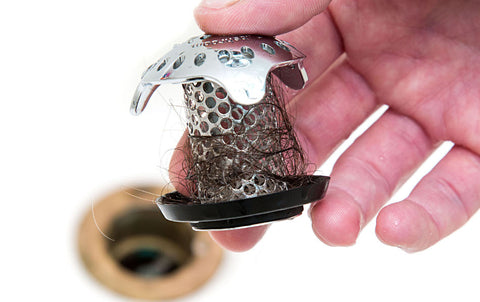
Regain Your Drain: How to Get Rid of Drain Flies
Share
The smell of icky drains appeals to drain flies. They enter your home through an open window or a cracked basement slab. Once inside, they make a nest inside your drains and breed. By the time you see them crawling near and around the drain, it’s too late. You'll look up "how to get rid of drain flies" online or call pest control, and every day wasted is a day for more drain flies to flourish.
It's frustrating, but homeowners can conquer this unfortunate situation. Learn what drain flies are, why drains are appealing to them, the warning signs, how to remove drain flies, and ways to block them from returning.
What Are Drain Flies?

Don't let the enlarged photo above fool you — drain flies are small, yet visible. A drain fly's appearance is like a moth fly or fruit fly. A common factor between the three is size. All are between 1.5 and 5 millimeters long. The difference is a drain fly has thick body hair and long antennae while a fruit fly is hairless with short antennae.
Compared to a moth, drain flies cannot fly as fast or as far. When they fly, they fly in an unbalanced manner. Therefore, they prefer to crawl on walls and hop around. Additionally, drain flies don't bite humans or animals upon contact.
Also called a sewer fly, a drain fly doesn't have a long life cycle. It lasts between one and three weeks. The problem lies in the eggs the females lay in your drain. One drain fly can lay up to 300 eggs in one day. If those 300 eggs hatch, grow to become larvae, and the females in the batch lay 300 more eggs within the same lifespan, the problem will multiply in a big way — it’s why you need to learn how to get rid of drain flies as soon as possible.
What Makes Your Drain Attractive to Drain Flies

Why do they like to lay eggs inside the drain? Drain flies gravitate to organic matter in standing water because they need the area to lay eggs. Once the eggs hatch and become larvae, they need to feed, so they feed on contaminated water, food crumbs, hair, toilet waste, dead skin cells, and bacteria inside drains. The kitchen, bathroom, and laundry room contain sink drains while the bathroom also contains a tub drain, shower drain, and toilet.
They love the dark and concealed environment drains provide because it’s a breeding ground for expansion; this is their home now. Drain flies also love sewers, sewage soil, and septic tanks. They love spots similar to drains such as compost, standing water storm drains, mops and buckets, birdbath water, and wet garbage.
Signs of a Drain Fly Infestation

Identify drain fly infestation in your pipes or wet areas by looking for these warning signs. If one factor fits your situation, it's time to learn how to get rid of drain flies.
-
Drain flies are visible inside the sink basin, around the sink basin, walking on the wall, and walking on the ceiling. This also doubles as a sign of clogged pipes.
-
Larvae love to breed around organic buildup near the drain opening, so open the drain cover and scrape the pipe drain with a small plastic or wooden utensil. What you are looking for is larva, a thin tube-like shape.
If neither reveals itself, a test can confirm whether drain flies are in the drain. Because drain flies come out at night, do this experiment before bed.
- Wipe any standing water in the drain.
- Use one strip of tape.
- Tape the drain with the sticky side down.
- Repeat steps 1-3 for every drain in the house.
- Leave it there overnight.
- The next morning, check for drain flies on the tape.
If you catch nothing the first time, try it every night for a week. Even if you only have a few drain flies, a sign should appear by then. The goal is not to trap all of them inside the drain but to catch some on the tape as evidence. This trick doubles as drain fly removal as you will toss the tape in the wastebasket afterward.
How to Get Rid of Drain Flies

Removing drain flies is not as easy as unclogging a drain. To eliminate a drain fly infestation, you need to destroy the adult drain flies along with the larvae. Completing one without the other leaves an opening for a re-infestation. If none of these methods work, contact an exterminator.
WARNING: Drain cleaners are effective for removing drain flies, but they will erode the drain pipe’s structure with continued use. If you notice water dripping through the pipe, stop using it. Additionally, pouring only boiling water down the drain is ineffective because the eggs and larvae can withstand hot drain conditions. Pair boiling water with another cleaning method for more effective results.
Eliminate the Eggs and Larvae
The eggs and soon-to-be larvae are the sources of the next generation of drain flies. Since there are hundreds of eggs and larvae in the drain, destroying the source will stop the adult drain fly from making more. Focus on the drains where there are signs of infestation.
Metal Pipe Brush
Remove slime and gunk around and near the drain opening with a stiff metal wire brush. As you go around the edges of the pipe, move the brush in an up and down motion. Pull it out and rinse the pipe brush under faucet water to clean it.
DrainShroom
A drain snake can remove any blockage deep inside the drain, including eggs, larvae, and clogs. However, drain snakes are difficult to use. An easier drain snake is the DrainShroom. This 42-inch drain snake attaches to any power drill and reaches any clog or blockage up to 3 feet inside drains. Just insert the coil end in the drain, connect the other end to the power drill, and use the drill to grab clogs, move the snake deeper in the pipe, and pull out the clog.
Baking Soda, Salt, and Vinegar
The combo of baking soda, salt, and vinegar down the drain is a home remedy that works well against eggs and larvae buildup. In this order, pour a cup of baking soda, a cup of salt, and two cups of vinegar down the drain before bed. Let it sit overnight, then flush the mixture down the drain with boiling water.
Eliminate the Adult Drain Fly
The adult drain fly doesn't last long, so when the eggs and larvae disappear, they won't have time to make more, hence why taking out the adult drain fly is second on the list.
Fly Swatter
Because they aren't good flyers, a fly swatter will be effective in catching the insects. Drain flies are easier targets when they are on the wall because you can maneuver the fly swatter in any direction to catch it.
Dish Soap and Warm Water
Kill drain flies in the sink basin, wall, or ceiling using a dish liquid and water mixture inside a spray bottle. Add two cups of warm water and 7 drops of dish liquid and shake. When you spot a drain fly, spray the fly with the mixture.
Soap, Vinegar, Sugar, and Water
This bittersweet and soapy DIY remedy lures flies to the mixture and traps them inside, drowning them. Before bed, mix one cup of vinegar, water, and sugar each into a bowl. Add ten drops of dish soap liquid to the mixture and mix again until the sugar dissolves. Leave the bowl near the sink overnight.
Ways to Fend Off Drain Flies

After going through the long-winded process of solving the drain fly problem, a reappearance of drain flies is the last thing you want to see. You must relearn how to get rid of drain flies if you don't use these preventative methods. Once is not enough for these insects. Use these methods often to prevent future infestations.
- Remove stagnant water sources. The sink drain, flower pots, fish bowls, pet bowls, appliance leaks, and buckets are examples of places where water sits. Wipe up sink drain water and appliance leaks with a towel and pour the remaining water sources outside.
- Fix leaky appliances. Avoid leaky appliances by hiring a plumber to fix them.
- Clean all pipe drains in the kitchen and bathroom. Since drain flies mostly live in drain pipes, thoroughly clean the pipe once a week. The home remedies used earlier in the article to remove drain flies can also clean pipe drains, break up clogs, and stop those insects from returning. For rarely used or unused drain areas, cover the drain with a stopper like the StopShroom or StopShroom Plug to block drain flies from using the pipe as their home.
- Clean toilet drains. The toilet bowl contains standing water drain flies love, but we need that water to flush out waste. Therefore, pour dish liquid into the drain to coat and soften stuck-on waste. After 30 minutes, use ToiletShroom to scrub off waste inside the drain. Afterward, flush the toilet.
- Wash the sink. Wash the sink basins with soap and hot water.
- Remove food sources in the kitchen. The sink and trash can contain wet leftover food crumbs for drain flies to thrive on. Transfer sink food crumbs to the trash can, empty sink strainers like the Kitchen SinkShroom, and transfer the trash from the trashcan to the city wastebasket outside. Also, hand-wash dishes or wash dishes in the dishwasher — don’t leave them sitting in the sink. Unwashed dishes contain food waste, and drain flies need to eat.
- Empty bathroom sink strainers. Sink strainers separate water from foreign objects by catching the objects and allowing water to pass through. An unclean drain catcher attracts drain flies. Grab your SinkShroom or drain strainer and empty its contents in the wastebasket.
Regain Your Drain and Silence Drain Flies Forever

The quote "give an inch, take a mile" says so much about drain flies. If you see one and let it pass, several more will appear.
Stop the infestation before it becomes overwhelming. Remember how to get rid of drain flies with the techniques listed in this article.
Are you looking to eliminate plumbing problems and clogged drains for good? Look no further than our complete 'Shroom drain protection line! We have award-winning solutions for every drain in your home.
Check out this video for more help on getting rid of drain flies!
Say Goodbye to Clogged Drains Forever
We here at the TubShroom Company have made it our mission to protect every drain in the world from clogs. We know how annoying it can be to see that dirty water start backing up. Hair is the #1 cause of clogged drains, so we set out to develop products that can catch every hair, every time. Learn more about our TubShroom family of products here.
When your bathtub, shower, sink, or toilet drain clogs, you either try a "snake" device to clear it out or--more typically--you pour harmful chemicals down the drain to try to dissolve the clog. When those attempts fail, the next step most people take is to call on a plumber who may charge upwards of $200 to clear the clog. TubShroom products can prevent clogs before they occur.
View all our top-selling, award-winning TubShroom products here. From the TubShroom to SinkShroom, and DrainShroom to ToiletShroom, there's something for everyone. Click here to product your drains for good.
More Articles From The Shroom Company
Plumbing Basics for the Average Homeowner
How To Clear Blocked Drains and Prevent Future Clogs
Slow Draining Tub: Causes, Fixes, and Prevention
The Ultimate Deep Cleaning Checklist (Plus Tools for the Job)
Disclosure: Links in this article are affiliate links to Amazon products. As an Amazon Associate, we earn from qualifying purchases.




